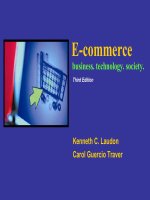Lecture E-commerce: Business, technology, society (3/e): Chapter 9 - Kenneth C. Laudon, Carol Guercio Traver
Bạn đang xem bản rút gọn của tài liệu. Xem và tải ngay bản đầy đủ của tài liệu tại đây (860.78 KB, 37 trang )
E-commerce
business. technology. society.
Third Edition
Kenneth C. Laudon
Carol Guercio Traver
Copyright © 2006 Pearson Education, Inc.
Slide 9-1
Chapter 9
Ethical, Social, and Political Issues
in E-commerce
Copyright © 2006 Pearson Education, Inc.
Slide 9-2
Warez Hackers End Up in the Slammer
Class Discussion
What are “Warez” groups? What are their
motivations? How to they differ from typical down
loaders?
What are the main specialties of wares groups?
Why are members of Warez groups facing criminal
charges and possible jail terms? What laws are they
violating?
How is the RIAA responding to illegal copying and
distribution of music files?
Copyright © 2006 Pearson Education, Inc.
Slide 9-3
Understanding Ethical, Social, and Political
Issues in E-commerce
Internet technology and its use in ecommerce disrupts existing social and
business relationships and understandings
Costs and benefits of technology must be
carefully considered, especially when there
are as yet no clear-cut legal or cultural
guidelines
Copyright © 2006 Pearson Education, Inc.
Slide 9-4
Unique Features of E-Commerce Technology and Their
Potential Ethical, Social and/or Implications
Table 9.1, Page 502
Copyright © 2006 Pearson Education, Inc.
Slide 9-5
A Model for Organizing the Issues
Issues raised by Internet and e-commerce can
be viewed at individual, social, and political
levels
Four major categories of issues
Information rights
Property rights
Governance
Public safety and welfare
Copyright © 2006 Pearson Education, Inc.
Slide 9-6
The Moral Dimensions of an Internet
Society
Figure 9.1, Page 503
Copyright © 2006 Pearson Education, Inc.
Slide 9-7
Basic Ethical Concepts
Ethics: Study of principles that individuals and
organizations can use to determine right and wrong
courses of action
Responsibility: As free moral agents, individuals,
organizations, and societies are responsible for the
actions they take
Accountability: Individuals, organizations, and
societies should be held accountable to others for the
consequences of their actions
Liability: Extends the concepts of responsibility and
accountability to area of law
Due process: Refers to process by which laws are
known and understood, with ability to appeal to
higher authorities to ensure that laws have been
correctly applied
Copyright © 2006 Pearson Education, Inc.
Slide 9-8
Analyzing Ethical Dilemmas
Process for analyzing ethical dilemmas:
1. Identify and clearly describe the facts.
2. Define the conflict or dilemma and
identify the higher-order values involved.
3. Identify the stakeholders.
4. Identify the options that you can
reasonably take.
5. Identify the potential consequences of
your options.
Copyright © 2006 Pearson Education, Inc.
Slide 9-9
Candidate Ethical Principles
One or more of the following well-established ethical
principles can be used to help you determine your
actions when confronted with an ethical dilemma:
Golden Rule
Universalism
Slippery Slope
Collective Utilitarian Principle
Risk Aversion
No Free Lunch
The New York Times Test (Perfect Information
Rule)
The Social Contract Rule
Copyright © 2006 Pearson Education, Inc.
Slide 9-10
The Concept of Privacy
Privacy: The moral right of individuals to be
left alone, free from surveillance or
interference from other individuals or
organizations
Information privacy: Includes both the claim
that certain information should not be
collected at all, as well as the claim of
individuals to control the use of whatever
information is collected about them
Copyright © 2006 Pearson Education, Inc.
Slide 9-11
E-commerce and Privacy
Major ethical issue related to e-commerce
and privacy: Under what conditions should
we invade privacy of others
Major social issue: Development of
“expectations of privacy” and privacy norms
Major political issue: Development of statutes
that govern relations between recordkeepers
and individuals
Copyright © 2006 Pearson Education, Inc.
Slide 9-12
Information Collected at E-commerce Sites
Personally identifiable information (PII): Data
that can be used to identify, locate, or contact
an individual
Anonymous information: Demographic and
behavioral information that does not include
any personal identifiers
Almost all e-commerce companies collect PII
and use cookies to track clickstream behavior
Copyright © 2006 Pearson Education, Inc.
Slide 9-13
Profiling and Behavioral Targeting
Profiling: Creation of digital images that characterize
online individual and group behavior
Anonymous profiles: Identify people as belonging to
highly specific and targeted groups
Personal profiles: Add personal identifiers
Advertising networks can:
Track both consumer behavior and browsing
behavior on the Web
Dynamically adjust what the user sees on screen
Build and refresh high-resolution data images or
behavior profiles of consumers
Copyright © 2006 Pearson Education, Inc.
Slide 9-14
Legal Protections for Privacy
May be explicitly granted or derived from
constitutions (U.S., Canada, Germany)
May also be found in common law (U.S,
England)
In U.S, also found in federal and state laws
and regulations
Copyright © 2006 Pearson Education, Inc.
Slide 9-15
Informed Consent
Consent given with knowledge of all the material
facts needed to make a rational decision
Two models:
Opt-in
Opt-out
Many U.S. e-commerce firms merely publish
information practices as part of privacy policy without
providing for any form of informed consent
Copyright © 2006 Pearson Education, Inc.
Slide 9-16
Statutory and Regulatory Protections of
Online Privacy
In U.S., Federal Trade Commission has taken lead in
conducting research and recommending legislation to
Congress
FTC Fair Information Practice Principles (1998):
Notice/Awareness (Core)
Choice/Consent (Core)
Access/Participation
Security
Enforcement
Copyright © 2006 Pearson Education, Inc.
Slide 9-17
FTC’s Fair Information Practice Principles
Table 9.7, Page 519
Copyright © 2006 Pearson Education, Inc.
Slide 9-18
FTC Recommendations Regarding Online
Profiling
Table 9.8, Page 520
Copyright © 2006 Pearson Education, Inc.
Slide 9-19
The European Directive on Data Protection
Privacy protection much stronger in Europe than in
United States
European approach: Comprehensive and regulatory
in nature
European Commission’s Directive on Data
Protection: Standardizes and broadens privacy
protection in European Union countries
Department of Commerce safe harbor program for
U.S. firms that wish to comply with Directive
Copyright © 2006 Pearson Education, Inc.
Slide 9-20
Private Industry Self-Regulation
Safe harbor: Private, self-regulating policy and
enforcement mechanism that meets objectives of
government regulations and legislation, but does not
involve government regulation or enforcement
Example: Privacy seal programs such as TRUSTe
Internet privacy protection program
Industry associations include:
Online Privacy Alliance
Network Advertising Initiative
Copyright © 2006 Pearson Education, Inc.
Slide 9-21
Insight on Business: Chief Privacy Officers
Class Discussion
What does a Chief Privacy Officers do?
Why do corporations need a CPO?
What is a “privacy audit?”
Why did ChoicePoint hire a CPO?
How do federal laws like Graham-Leach
Bliley and HIPPA influence corporate privacy
practices?
What is a “legalistic” approach to privacy as
opposed to a “pro-consumer” approach?
Copyright © 2006 Pearson Education, Inc.
Slide 9-22
Technological Solutions to Privacy
Invasion on the Web
Many privacy-enhancing technologies being
developed emphasize security
Platform for Privacy Preferences (P3P):
Comprehensive technological privacy protection
effort sponsored by W3C
Is a standard designed to communicate to Internet
users a Web site’s privacy policy, and to compare
that policy against user’s preferences or to other
standards such as FTC’s FIP guidelines or EU’s
Data Protection Directive
Copyright © 2006 Pearson Education, Inc.
Slide 9-23
How P3P Works
Figure 9.2(A), Page 527
SOURCE: W3C Platform for Privacy Preferences Initiative, 2003.
Copyright © 2006 Pearson Education, Inc.
Slide 9-24
Internet Explorer 6.0’s Implementation
of P3P
Figure 9.2(B), Page 528
Copyright © 2006 Pearson Education, Inc.
Slide 9-25









